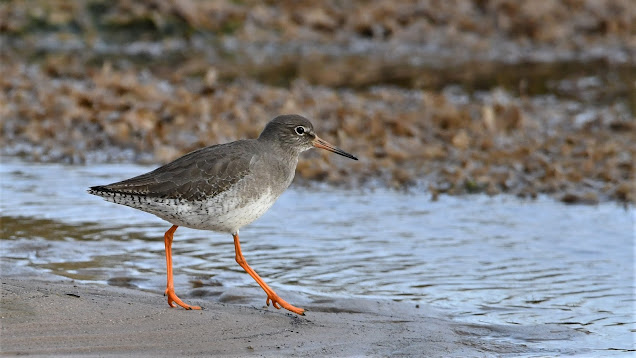28th February. Remaining unsettled with regular bouts of fine drizzle and a north wind.
At least 5 Water Pipits around today with 3 of them showing very well on the Fenland Lagoon with 2 Rock Pipits (one of each littoralis and petrosus apparently). Poor visibility at sea precluded any seawatching but 7 Snow Buntings were along the beach. 4 high-flying Redwings appeared to be new arrivals, a Barn Owl was hunting the Old Saltmarsh late afternoon and 3 Marsh Harriers went to roost.
27th February. An unsettled morning with occasional rain showers, mixed sunny and cloudy intervals and a persistent cold northerly wind.
This mornings survey concentrated on counting the wildfowl around the lagoons; highlights being 580 Brent Geese, 17 Shoveler, 48 Tufted Duck, 3 Pochard and a Pintail. Still a good batch of unidentified Pipits around the Old Saltmarsh, but a small sample feeding periodically on the Fenland Lagoon proved that three species are involved.
26th February. A moderate north-easterly wind keeping temperatures down, but otherwise, dry, and sunny.
Not much change today, although 8 Woodcock flushed form a relatively small area indicated an influx. Otherwise, a single Goldeneye flew north in a very brief seawatch, an immature male Merlin hunted waders along the beach, 2 Siskin and 6 Rock Pipit flew south. Little Grebes were vocal on the lagoons this morning and other birds in song included Skylark, Red Bunting, Chaffinch, Greenfinch, Robin and Dunnock.
25th February. A strong northerly wind.
The north winds produced little at sea, the highlight being a Fulmar. Birds around included 700 Brent Geese, 820 Pink-footed Geese, 47 Whooper Swan and 10 Snow Bunting.
24th February. Another big tide this morning and another impressive wader roost. Knot were well represented with 14,700 whilst the Dunlin count of 8290 was exceptional for February. There were also 4060 Grey Plover and 400 Sanderling. 12 Snow Bunting were along the beach, 45 Whooper Swan were in the fields and 4 Stonechats were around. A Great Black-backed Gull provided entertainment as it managed to down a large Dogfish over the course of 35 minutes! Other birds of note that have only been thinly recorded so far this year included Green Woodpecker, Collared Dove and Yellowhammer.
Gibraltar Point Bird Observatory data - first 10 years now digitised and submitted to BTO's BirdTrack - see details here:
https://www.lincstrust.org.uk/news/52000-historic-bird-records-made-available-research
23rd February. Early morning rain, then overcast with moderate northerly wind. The combination of predicted high tides, residual effects of Storm Otto and northerly winds amounted to the highest tide witnessed since the storm surge of December 2013. Although, still way off that level, the tidal flooding across the saltmarsh and the outer dunes from the previous evening tide was impressive and this mornings tide too was well above predicted level.
The morning tide saw another very good roost of Dunlin (6700), Bar-tailed Godwit (2300) and Grey Plover (3860) amongst other waders, although the large Knot flock present earlier in the week did not come up to the main roost and may have moved over to crop fields. A Peregrine arrived at the roost and caused mayhem before landing on the shingle bar. 300 Brent Geese came onto Tennyson's Sands and a Barn Owl was hunting around the south end.
22nd February. Rain for the first part of the morning then increasing wind becoming northerly.
Todays highlights were 12 Greenfinch and 6 Siskin at the feeding station, 500 Brent Geese on the lagoons, 16 Little Egret at the pre-roost on Jackson's Marsh in the evening with 2 Marsh Harriers going to roost there.
21st February. Little change in the weather, remaining mild and dry with a south-westerly breeze.
Another big tide this morning with a noticeable increase in Grey Plover and Dunlin; 3400 and 4600 respectively. After yesterdays Spoonbill sightings at two coastal sites, 2 arrived with us today and were different from those seen elsewhere in the mini-influx. Otherwise, Pipits provided interest and challenges during the day. The first spring movement of Meadow Pipits involved 18 south and 5 grounded whilst 9 Rock Pipits flew south with another 25 around. 3 Water Pipits came off the Freshwater Marsh and the evening Pipit roost on the Old Saltmarsh involved 31 Rock or Water Pipits.


.JPG)

.JPG)
.JPG)
.JPG)



.JPG)

















